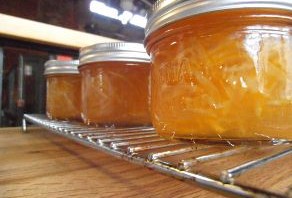Taste the Sunshine – Lemon Marmalade
03/15/12

Every Saturday morning at 9 am in the Market Kitchen, historian Bruce Bell (www.brucebelltours.ca) entertains us with stories about St. Lawrence market and Toronto’s past while one of our chefs demonstrates a seasonal recipe. Last week, we were inspired by all the beautiful citrus fruits around the market and so the theme was marmalade. According to Bruce, it was Queen Victoria who popularized marmalade and it soon became a favourite treat of the Empire, following the British all around the world. This winter, the various market vendors sold array of exotic citrus fruits that are perfect for marmalade making – like Spanish Seville oranges, Italian blood oranges, Chinese kumquats and Meyer Lemons from California. So for our Saturday show, we made marmalade from Meyer lemons – a lemon-orange cross with lots of tart-sweet juice and a thin fragrant skin. Served with fresh croissants from Stonemill Bakehouse – what a way to start the day!
Classic marmalade is made from just three ingredients – citrus fruit, sugar and water. Though it is still a bit of a luxury item, it is also the perfect example of Victorian economy as every bit of the fruit is used: juice, peel, seeds and membranes. Marmalade is characterized by the copious amount of peel in the preserve, and unlike most recipes using citrus peel, the white pith is left it on and imparts a wonderfully bitter flavor.
Natural pectin is produced from the fruit’s seeds and membranes – this is what makes the marmalade set. Juice, water, peel, etc. are cooked down until the peel is very tender (the length of time varies with the type of citrus fruit used and the thickness of its peel) and when done properly, the peel is sliced as thinly as possible and cooked until very soft – almost mushy between your fingers.
If you like making jam but have never made marmalade, it’s worth a try. It takes some time to prepare the fruit and boil down the mixture, but the results are fabulous. And there are still beautiful Meyer Lemons all over the market. It won’t be long now before the summer berries, etc. start arriving and then we will hold some preserving workshops in the Market Kitchen, so watch our events page for upcoming jam, jelly and pickle making classes. Enjoy!
MEYER LEMON MARMALADE
Makes about 6 x 250 mL jars
INGREDIENTS:
2 lbs Meyer lemons
5 cups sugar
METHOD:
Scrub lemons; cut off stem and blossom ends. Cut in half and squeeze out juice, reserving pulp and seeds. Strain juice through sieve into large pot.
Cut lemon peels in half and pull out membranes. Tie-up membranes, pulp and seeds in a 15-inch square piece of double-thickness cheesecloth and add to the pot.
Cut skins crosswise into paper-thin strips. Add to the pot.
Add 5 cups water; bring to simmer over medium heat. Simmer, stirring often and pressing cheesecloth bag to release pectin, until peel turns to mush when pressed between fingers, about 45 minutes.
Remove cheesecloth bag and let cool; squeeze juice into pot. Mixture should measure 5 cups (If not, add water to make up difference or boil until reduced to this amount.) Transfer to clean large pot. Add sugar and bring to full rolling boil, stirring. Boil vigorously, stirring, until free of foam, thickened and at gel stage, 7 to 10 minutes. (*Gel stage: Place spoonful of hot mixture on chilled plate. Place plate in freezer until cooled, about one or two minutes. Run your finger through the mixture – gel is achieved when marmalade does not run together when separated.)
Quickly ladle hot marmalade into hot 250 mL canning jars leaving 1/4 inch at top of jar (headspace). Using nonmetallic utensil, remove air bubbles and adjust headspace, if required, by adding more marmalade. Wipe rim removing any residue. Centre hot sealing disc on clean jar rim. Screw band down until resistance is met, then increase to fingertip tight. Return filled jar to rack in canner. Repeat for remaining marmalade.
When canner is filled, ensure that all jars are covered by at least one inch of water. Cover canner and bring water to full rolling boil before starting to count processing time. Boil for 10 minutes.
When processing time is complete, turn stove off, remove canner lid, wait 5 minutes, then remove jars without tilting and place them upright on a protected work surface. Cool upright, undisturbed 24 hours.







